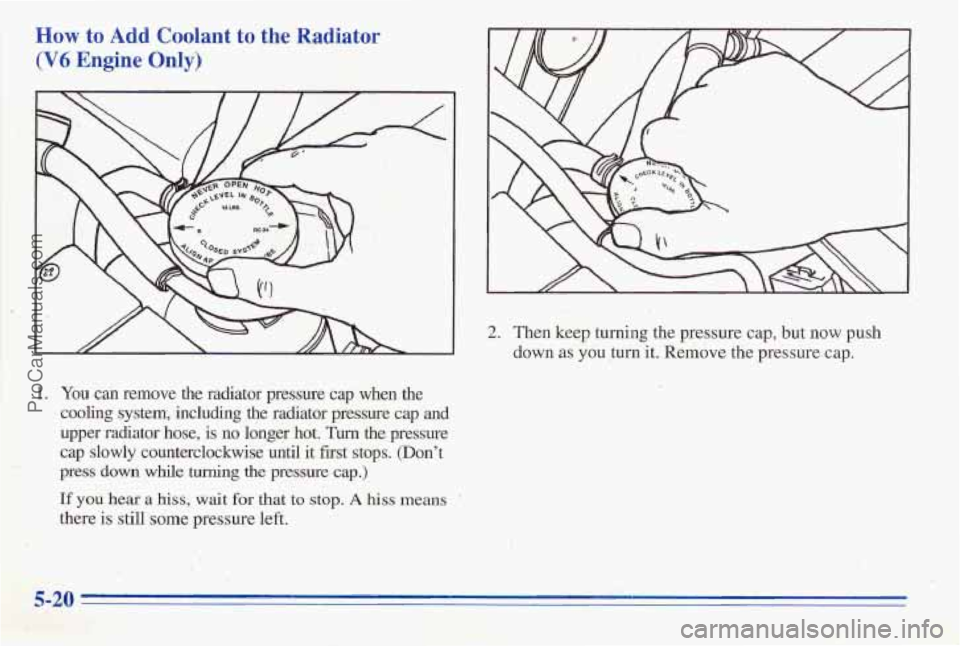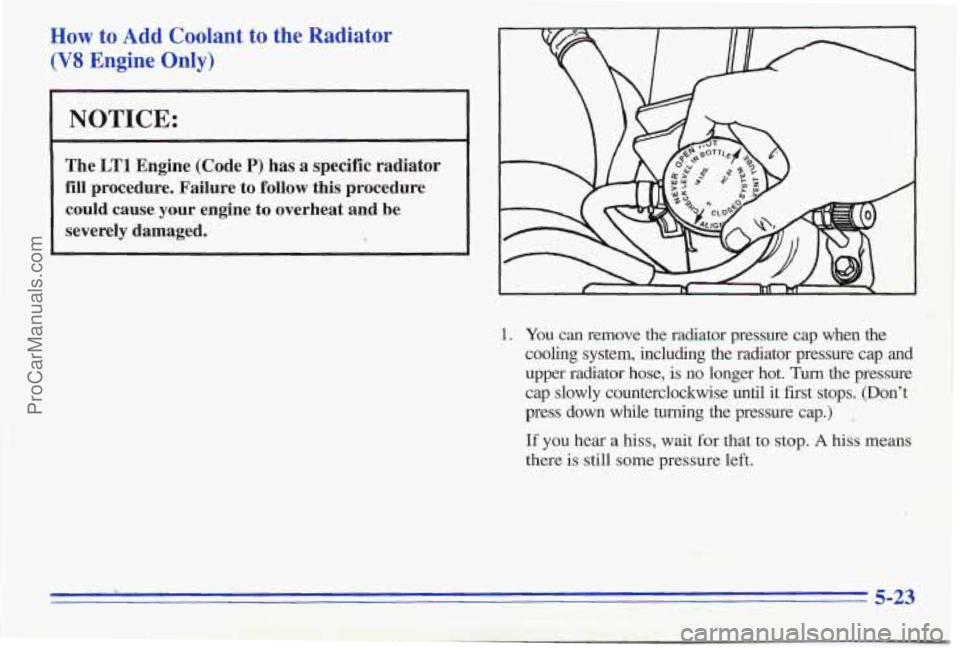radiator PONTIAC FIREBIRD 1996 Owners Manual
[x] Cancel search | Manufacturer: PONTIAC, Model Year: 1996, Model line: FIREBIRD, Model: PONTIAC FIREBIRD 1996Pages: 386, PDF Size: 19.18 MB
Page 131 of 386

Low Coolant Light (V8 Engine)
LOW
COOLANT
I
This warning light should
come on while
you are
starting your engine. If the
light doesn’t come on, have
it repaired.
Your Firebird
is equipped with a LOW COOLANT
indicator which is designed to detect when the coolant
level
drops below set limits. If the low coolant level
sensor (on the radiator)
drops while the engine is
running, ‘the LOW COOLANT indicator will light
and remain lit until the ignition switch is turned to
the
OFF position. Check coolant level and add coolant
as needed. The LOW COOLANT light might stay on
after filling the radiator., Turn the ignition switch to the
OFF position, then restart the engine to verify that the
LOW COOLANT light goes out. See “Engine Coolant”
in the Index.
~
NOTICE:
Driving with the LOW COOLANT light on could
cause your Pontiac to overheat. See “Engine
Overheating’’
in the^ Index. Your Pontiac could be
damaged md it wouldn’t be covered by your
warranty.
2-82
ProCarManuals.com
Page 214 of 386

When you decide it’s safe to lift the hood, here’s what
you’ 11 see: When
you decide
it’s safe to lift the hood, here’s what
you’ll see:
V8 Engine
1. Coolant Recovery Tank
2. Radiator Pressure Cap
3. Electric Engine Fan
V6 Engine
1. ’Coolant Recovery Tank
2. Radiator Pressure Cap
3. Electric Engine Fan
ProCarManuals.com
Page 215 of 386

An electric fan under the hood can start up even
when the engine
is not running and can injure
you. Keep hands, clothing
and tools away from
any underhood electric fan,
If the coolant inside the coolant recovery tank is boiling,
don’t do anything
else until it cools down.
When it is cool, remove the coolant recovery tank cap
and
look at the dipstick.
The coolant level should be at FULL COLD. If it
isn’t, you may have a leak in the radiator hoses, heater
hoses, radiator, water pump or somewhere else in
the
cooling system.
5-16
ProCarManuals.com
Page 216 of 386

Heater and radiator hoses, and other engine
parts, can be very hot. Don’t touch them.
If you
do, you can be burned.
Don’t run the engine if there is a leak.
If you run
the engine, it could lose all coolant. That could
cause
an engine fire, and you could be burned.
Get any leak fixed before you drive the vehicle.
NOTICE:
Engine damage from running your engine
without coolant isn’t covered by your warranty.
If there seems to be no leak, with the engine on, check to
see if the electric engine fan is running. If the engine
is
overheating, the fan should be running. If it isn’t, your
vehicle needs service.
How to Add Coolant to the Coolant
Recovery Tank
If you haven’t found a problem yet, but the coolant level
isn’t at
FULL COLD, add a 50/50 mixture of clean
water
(preferably distilled) and DEX-COOL TM
(orange-colored, silicate-free) antifreeze at the coolant
recovery tank. (See “Engine Coolant” in the Index for
more information.)
I A CAUTION:
Adding only plain water to your cooling system
can be dangerous. Plain water, or some other
liquid like alcohol, can boil before the proper
coolant mix
will. Your vehicle’s coolant warning
system is set for the proper coolant mix. With
plain water or the wrong mix, your engine could
get too hot but you wouldn’t get the overheat
warning. Your engine could catch fire and you or
others could be burned. Use a
50/50 mix of clean
water and
DEX-COOL TM antifreeze.
ProCarManuals.com
Page 217 of 386

NOTICE:
.In cold weather, water can freeze and crack the
engine, radiator, heater core
and other parts.
Use the recommended coolant and the proper
coolant
mix.
- -
You can be burned if you spill coolant on hot
engine parts. Coolant contains ethylene glycol
and it will burn
if the engine parts are hot
enough. Don't
spill coolant on a hot engine.
When the coolant in the coolant recovery tank is at
FULL COLD, start your vehicle.
If the overheat warning continues, there's one more
thing you can try. You can add the proper coolant mix
directly to the radiator, but be sure the cooling system is
cool before you do it.
5-18
ProCarManuals.com
Page 218 of 386

Steam and scalding liquids from a hot cooling
system can blow out and burn you badly. They
are under pressure, and if you turn the radiator
pressure cap
-- even a little -- they can come out
at high speed. Never turn the cap when the
cooling system, including -the radiator pressure
cap,
is hot. Wait for the cooling system and
radiator pressure cap to cool
if you ever have to
turn the pressure ca,p.
5-19
ProCarManuals.com
Page 219 of 386

HOW to Add Coolant to the Radiator
i'l (V6 Engine Only)
2. Then keep turning the pressure cap, but now push
down
as you turn it. Remove the pressure cap.
1. You can remove the rachator pressure cap when the
cooling system, including ,&e radiator pressure cap Bnd
upper radiator hose,
is no longer hot. Turn the pressure
cap slowly counterclockwise until
it first stops. (Don't
press down while turning the pressure cap.)
If you hear a hiss, wait for that to stop. A hiss means '
there is still some pressure left.
5-20
ProCarManuals.com
Page 220 of 386

3. Fill the radiator with the proper mix, up to the base
of the filler neck.
4.
5.
Then fill the coolant recovery tank to FULL COLD.
Put the cap back on the coolant recovery tank, but
leave the radiator pressure cap
off.
ProCarManuals.com
Page 221 of 386

6. Start the engine and let it run until you can feel the
upper radiator hose getting hot. Watch out for the
engine
fan.
filler neck may be lower. If the level is lower, add
more
of the proper mix through the filler neck until
the level reaches the base
of the filler neck.
7. By this time the coolant level inside the radiator
8. Then replace the pressure cap. At any time during
this procedure if coolant begins to flow out
of the
filler neck, reinstall the pressure cap. Be sure the
arrows on the pressure cap line up like this.
, 'I I
5-22
ProCarManuals.com
Page 222 of 386

How to Add Coolant to the Radiator
(V8 Engine Only)
NOTICE:
The LTl Engine (Code P) has a specific radiator
fill procedure. Failure to follow this procedure
could cause your engine to overheat and be
severely damaged.
<
I
1. You can remove the radiator pressure cap when the
cooling system, including the radiator pressure cap and upper radiator hose, is
no longer hot. Turn the pressure
cap slowly counterclockwise until it first stops. (Don’t
press down while turning the pressure cap.)
.
If you hear a hiss, wait for that to stop. A hiss means
there is still some pressure left.
ProCarManuals.com